The Google Nexus 9 Review
by Joshua Ho & Ryan Smith on February 4, 2015 8:00 AM EST- Posted in
- Tablets
- HTC
- Project Denver
- Android
- Mobile
- NVIDIA
- Nexus 9
- Lollipop
- Android 5.0
CPU Performance
While Denver’s architecture is something fascinating to study, it’s important to see how well this translates to the real world. Denver on paper is a beast, but in the real world there are a number of factors to consider, not the least of which is the effectiveness of NVIDIA’s DCO. We’ve laid out that Denver’s best and worst case scenarios heavily ride on the DCO, and for NVIDIA to achieve their best-case performance they need to be able to generate and feed Denver with lots and lots of well optimized code. If Denver spends too much time working directly off of ARM code or can’t do a good job optimizing the recurring code it finds then Denver will struggle. Meanwhile other important factors are in play as well, including the benefits and drawbacks of Denver’s two cores versus competing SoC’s quad A15/A57 configurations, and in thermally constrained scenarios Denver’s ability to deliver good performance while keeping its power consumption in check.
In order to test this and general system performance, we turn our suite of benchmarks that include browser performance tests, general system tests, and game-type benchmarks. As Denver relies on code-morphing to enable out of order execution and speculative execution, most of these benchmarks should be able to show ideal performance as loop performance in Denver is basically second to none. While most of these benchmarks are showing their age, they should be usable for valid comparisons until we move to our new test suite.
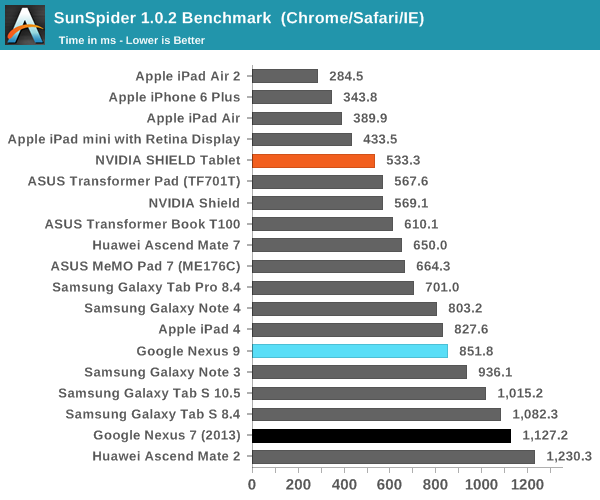
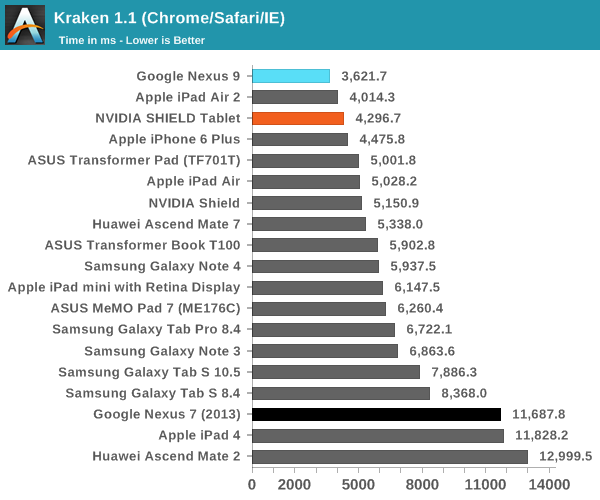
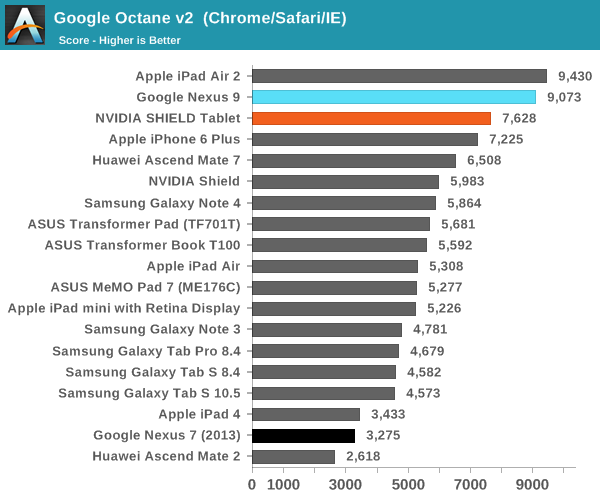

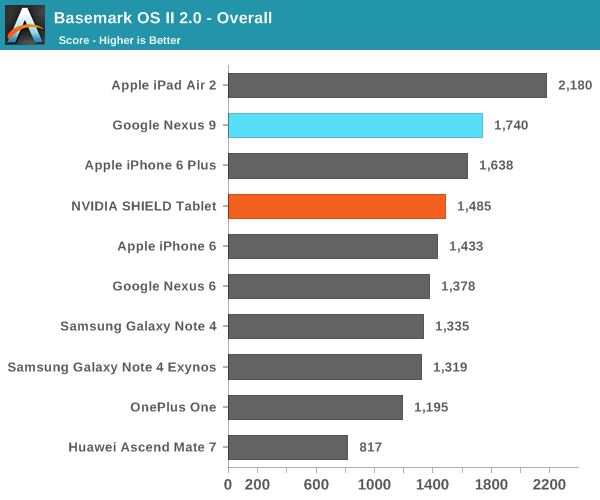

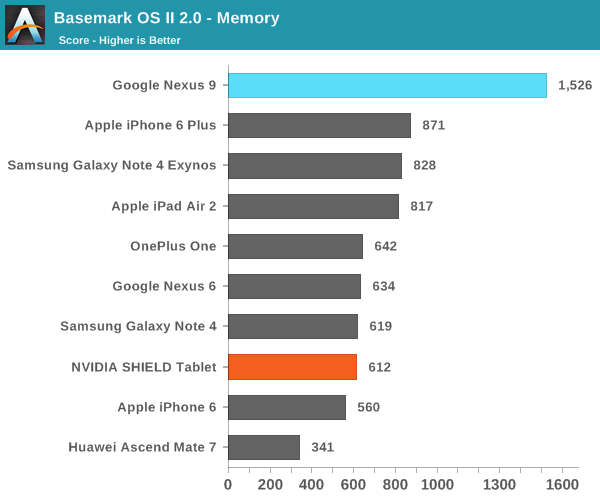
The Basemark System test seems to contribute quite strongly to how the Nexus 9 performs in the overall subtest. Given that this is a storage performance benchmark, it's likely that Basemark OS II has issues similar to Androbench on 5.0 Lollipop or that random I/O is heavily prioritized in this test.
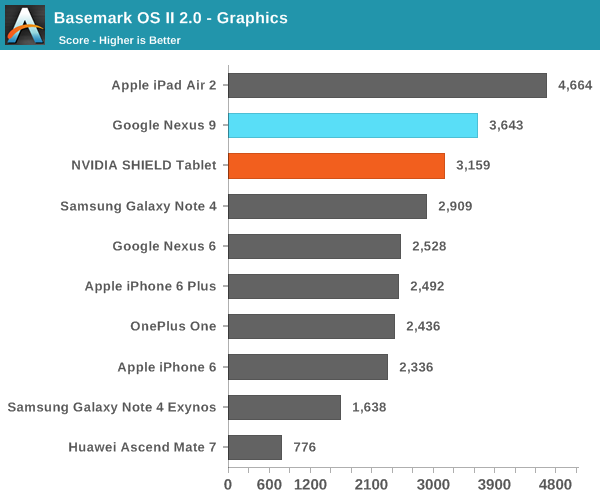
There's a noticeable performance uplift in the graphics test, and although not exactly part of the CPU this does seem at least somewhat plausible as GPU driver updates can improve performance over time.
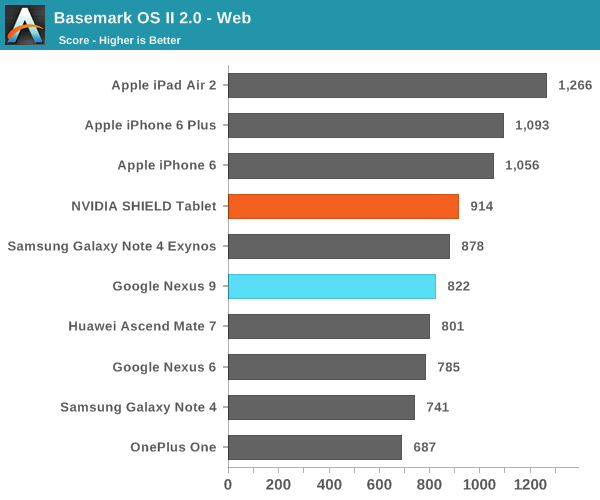
Overall, performance seems to be quite checkered, although improved from our initial evaluation of the Nexus 9. Unfortunately, even in benchmarks where the DCO should be able to easily unroll loops to achieve massive amounts of performance, we see inconsistent performance in Denver. This may come down to an issue with the DCO, or even more simply the fact that Denver is spending more time than it would like to directly executing ARM code as opposed to going through the DCO.
In this case looking at the SunSpider and Kraken javascript benchmarks offers an interesting proxy case for exactly that scenario. SunSpider on modern CPUs executes extremely quickly, so quickly that the individual tests are often over in only a couple of dozen of milliseconds. This is a particularly rough scenario for Denver, as it doesn’t provide Denver with much time to optimize, even if the code is run multiple times. Meanwhile Kraken pushes many similar buttons, but its tests are longer, and that gives Denver more time to optimize. Consequently we find that Denver’s SunSpider performance is quite poor – underperforming even the A15-based Tegra K1-32 – while Denver passes even the iPad Air 2 in Kraken.
Ultimately this kind of inconsistent performance is a risk and a challenge for Denver. While no single SoC tops every last CPU benchmark, we also don’t typically see the kind of large variations that are occurring with Denver. If Denver’s lows are too low, then it definitely impacts the suitability of the SoC for high-end devices, as users have come to expect peppy performance at all times.
In practice, I didn't really notice any issues with the Nexus 9's performance, although there were odd moments during intense multitasking where I experienced extended pauses/freezes that were likely due to the DCO getting stuck somewhere in execution, seeing as how the DCO can often have unexpected bugs such as repeated FP64 multiplication causing crashes. In general, I noticed that the device tended to also get hot even on relatively simple tasks, which doesn't bode well for battery life. This is localized to the top of the tablet, which should help with user comfort although this comes at the cost of worse sustained performance.










169 Comments
View All Comments
coburn_c - Wednesday, February 4, 2015 - link
High end my rear end. HTC has made high end tablets, HTC makes high end devices, Google makes high end companies make garbage. Seriously. Google devices are done.rpmrush - Wednesday, February 4, 2015 - link
On the cover page it has a tag in the top right saying, "HTX Nexus #2". Should be HTC?cknobman - Wednesday, February 4, 2015 - link
So regardless of how nice the hardware it Android (and more importantly most of its apps) still have major issues when it comes to tablets.Why waste time buying this stuff when you can get a Windows 8 tablet?
I get the best of both tablet and PC worlds in one device without being held hostage by lord overseer Apple dictating my every move or Androids crappy support and busted app ecosystem.
milkod2001 - Wednesday, February 4, 2015 - link
@cknobmanthere's no Windows 8 tablet out there for the same price,with same quality screen and snappiness as this one or Apple tablets. The closest would be Surface3 but it's much more expensive.
If you happen to know about any please post some links please.
rkhighlight - Wednesday, February 4, 2015 - link
Because a Windows 8 tablet is worse than a tablet when it comes to tablet user experience and worse than a notebook when it comes to notebook experience. Most people like to have two separate devices rather than owning a product that tries to combine everything. For some people this works but the majority prefers two product.milkod2001 - Wednesday, February 4, 2015 - link
not necessarily if done right. Lenovo Yoga comes probably the closest with its hybrid(tablet +notebook). It need to be much cheaper if it wants to be acquired by majority though.melgross - Wednesday, February 4, 2015 - link
The Yoga got terrible reviews everywhere. It's hardly recommended.Midwayman - Wednesday, February 4, 2015 - link
I don't think that's true at all. Most people would probably prefer to only pay for one device. The issue is one more of execution than concept. If the surface pro 3 were as light, thin, and as good on battery as high end tablets I certainly would have bought one. At a premium even.Impulses - Wednesday, February 4, 2015 - link
It that were true MS wouldn't be able to keep Surface on the shelves and the market for x86 Atom hybrids at <$500 would be comprised of more than a handful of OEM & models...I think for a certain class of individuals it makes all the sense in the world; students, business travelers, etc. For most people however it's just a compromise on both form factors and not really much of a money saver (specially when you factor the upgrade cycle into the equation).
steven75 - Thursday, February 5, 2015 - link
I have a Windows 8.1 tablet (not RT). It's the worst tablet interface I've used yet. A total bomb. And the touch apps and selection are universally awful.If it didn't have "classic" Windows desktop, I'd have sent it back to the store.